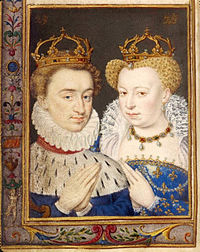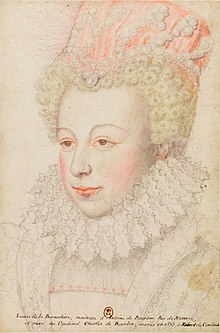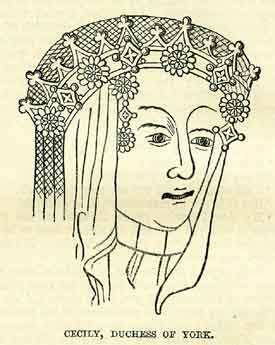Marguerite of Valois, infamously known as Reine Margot, was born May 14th 1553 at the Château of St. Germain-en-Laye to Henry II of France and his Queen, Catherine de’Medici. Again, a fairytale princess come to life – a beauty with her dark eyes, intelligent with a fabulous fashion sense. But she had a dark side as well – she became well known for her scandals and extra marital affairs and worse still her August 18th 1572 wedding was overshadowed by the St. Bartholomew’s Day massacre when the Catholic supporters of her family instigated a wave of terror and violence against the Protestant Huguenots, which was a huge problem considering her husband was the Huguenot King of Navarre. Yeah ... not a great start to the marriage – my family kills your family on our wedding day ... love you! To Marguerite’s credit she did save her husband’s life and the lives of other Protestants by hiding them in her rooms at the Louvre.
Poor Marguerite – it seems as if her life was marked by tragedy after tragedy but her spirit proved to be impossible to break. As a young girl Marguerite was madly in love with Henri de Lorraine, Duc de Guise but her family refused this match – they had much bigger plans for her considering one of her sisters married the King of Spain and the other to the Duke of Lorraine.

Marguerite and Henry IV
Marguerite was married to her cousin, Henri of Navarre. Neither Marguerite nor Henri were too thrilled with this arraignment and it’s probably not surprising that their marriage was not a happy one considering the events that took place on their wedding day. Both Marguerite and Henri openly took lovers and seemed pretty content with their separate lives. They did however present a united front against Marguerite’s family, whom she seems to have disliked immensely.
Somehow Marguerite managed to alienate herself from both her husband and her brother Henri III in 1582. Henri III actually banished his sister from his court and had her imprisoned in the Château d’Usson where she remained a prisoner for 19 long years. Even this did not break her ... Marguerite decided to use this time to write her memoirs and no secret was kept and no one was safe. She dished about her own love affairs, the love affairs of her husband and brothers, everything was revealed.

In 1575, Marguerite’s brother Henri III was assassinated and since he died with no heir the crown of France fell onto the head of her husband, now Henri IV, King of France and Navarre therefore making Marguerite Queen of France and Navarre. Her scandalous lifestyle and lack of children proved to be a problem – now that she was Queen she needed to produce an heir to the throne and she needed to live a life of decorum – one befitting of a Queen, not a harlot. This proved to be too much for Henri and it didn’t take long for him to start the annulment process and plans to marry a younger, beautiful possibly foreign princess and to drop the dead weight of his aging, barren wife.
The annulment didn’t really faze Marguerite and she gave in gracefully to her husband’s request. She continued to stylize herself as la Reine Margot and lived in a magnificent mansion on the banks of the Seine in Paris, and she was even welcomed at court of her former husband and his new bride Marie de’Medici. Marguerite lived out her life in comfort in her mansion and she died on March 27th 1615 at the age of 61.

